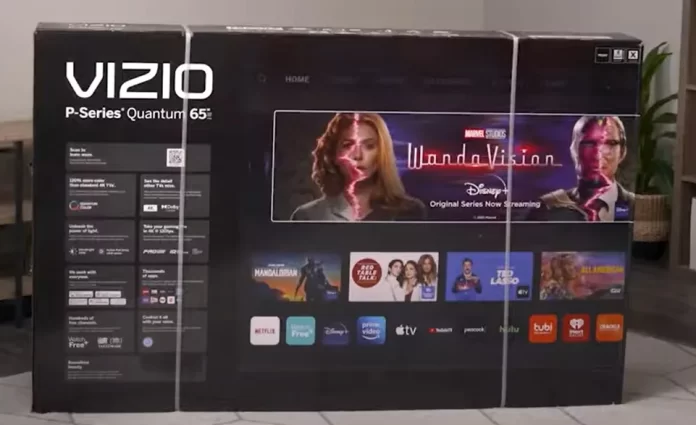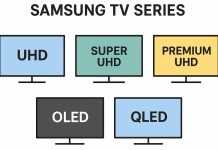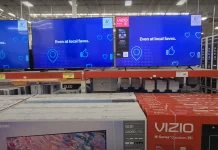If you are considering buying a Vizio TV, here’s what you should know. Vizio, a company incorporated in the United States, is one of the most prominent North American TV market players. Although Vizio is positioned as an American brand, it doesn’t manufacture its TVs. Instead, its products are manufactured by third-party manufacturers known as OEMs (Original Equipment Manufacturers) and ODMs (Original Design Manufacturers).
According to Statista, Vizio had a 13% share of the U.S. TV market in 2020, making it the third-largest supplier. However, since 2017, the company’s market share has dropped by more than half as Chinese competitors such as TCL and Hisense have been aggressively expanding their presence in North America, offering similarly priced TVs.
What you need to know about Vizio TVs
We offer you a helpful overview if you want information about Vizio TVs. Whether you choose a Full HD model or a Quantum Pro TV, Vizio TVs are usually positioned in the budget segment. Today’s Vizio models utilize technologies that were considered high-end even five years ago. A key advantage of Vizio TVs is their affordability. While the picture quality doesn’t compare to premium models from market leaders, it’s quite acceptable – and certainly better than TVs from a decade ago.
Vizio also offers models with HD and Full HD resolutions, which have been obsolete for more than five years. However, these displays cost less, making Vizio an attractive option for those looking to save money.
Key considerations when buying a Vizio TV
When evaluating a Vizio TV, looking beyond the marketing claims and focusing on the technical details is essential. For example, Vizio’s Quantum Pro 2023 model, the VQP65C-84, is advertised as supporting 4K at 120Hz and Full HD at 240Hz. However, the refresh rate is limited to 120Hz if you examine the display specifications. Although the HDMI ports can receive Full HD signal at 240Hz, the TV cannot display it, which means the frames will drop out and the displayed video frequency will remain at 120Hz. Thus, this feature offers no real advantage.
In addition, although the Vizio Quantum Pro series supports Wi-Fi 6E, this standard is primarily intended for high-density environments such as offices or stadiums. Wi-Fi 6E is only necessary for typical home use if you purchase a router that supports this standard and a 10Gbps Internet connection. Without these, Wi-Fi 6E has no significant advantage over Wi-Fi 5.
Who owns the Vizio brand?
About 89% of Vizio’s shares are owned by the company’s management. A few private investors and a few companies with minor stakes hold the remaining shares. Among them is Hon Hai Precision Industry Co. (better known as Foxconn), although its stake is not significant enough to affect the company’s overall strategy.
In early 2024, it was announced that Walmart had reached an agreement to acquire Vizio. However, the deal is subject to regulatory approval and is expected to be finalized in January 2025. Notably, this is not the first attempt to sell Vizio—back in 2016, there was a failed attempt to sell the company to a Chinese buyer.
Vizio’s business model
Vizio’s business model was developed in the early 2000s during rapid technological change in the electronics market. Many companies started manufacturing electronics at that time without developing their brands. Vizio decided to focus on selling televisions and buying finished products under the Vizio brand. The 2000s saw a shift from bulky 1980s-style TVs to more modern models, and by the end of the 2010s, the shift to flat-panel LED TVs began, and from the early 2010s to smart TVs with OS, TVs could not only show video but also receive streaming video via Wi-Fi or wired connections.
Until 2014, Vizio experimented with other product lines, including tablets, laptops, and phones, but competition from Chinese manufacturers prevented it from succeeding in those markets. Recognizing the potential of Smart TVs, Vizio launched its SmartCast platform in 2016, which became the operating system for its TVs. The company decided to sell TVs and show advertisements through its platform. By offering affordable TVs, the company quickly gained market share, and by 2024, it had about 19 million active SmartCast accounts.
However, despite this growth, many Vizio TV owners still need to activate a SmartCast account. They prefer to use their TVs as monitors with HDMI streaming devices such as FireStick or Roku. To expand its presence in the Smart TV market, Vizio announced in 2023 that it will license its operating system to third-party manufacturers. However, this may be too late as many manufacturers have already moved to platforms like Android, Google, Roku, or Fire TV. Vizio also offers a mobile app that allows users to stream content directly to their TV.
Comparing Vizio’s and Apple’s business models
While some compare Vizio’s business model to Apple’s, the two companies differ significantly in their approach. Apple develops and tests its products, offering premium electronics integrated into a single ecosystem. Conversely, Vizio outsources all manufacturing and development, focusing mainly on business planning and logistics. While Apple is known for its innovation and quality, Vizio prioritizes the affordability of its electronics, offering only TVs and soundbars.
Where Vizio TVs and soundbars are manufactured
Vizio TVs are predominantly assembled in China and Mexico. The leading supplier is the Taiwanese company AmTRAN, which manufactures about half of Vizio TVs in its Chinese factories. In addition, Foxconn, a major electronics manufacturer, assembles TVs in Mexico. Some Vizio products are manufactured entirely in China, while others are completed with components from China and then assembled in Mexico. Several companies may be involved in the manufacturing process, but where the TVs are assembled matters less than the quality of the components, particularly the displays, which could have been better in recent models.
The future of Vizio TV and soundbar manufacturing
The future of Vizio TV and soundbar manufacturing remains to be determined significantly since the company may change ownership. If Walmart completes its acquisition of Vizio, the company’s direction will largely depend on the strategy of Walmart’s management team. Walmart’s value lies in Vizio’s SmartCast subscriber base, which is opening up advertising revenue opportunities. While TV production is likely to continue, sales could decline due to increased competition from brands such as Hisense and TCL and the growing popularity of alternative platforms.







Vizio’s products are 100% outsourced, and the joint manufacturers are Ruixuan Technology and Foxconn.
https://baike.baidu.com/item/Vizio/9850224
Inaccurate article. Vizio is a U.S. company, products are designed in the U.S. (California). They are assembled in Vietnam, Taiwan and Mexico. The China is not part of the equation. Vizio is on par with more costly brands, especially given price points.
It doesn’t matter, Vizio has never made TVs on its own. And you won’t find any information in the public domain about who made a Vizio TV.
This article is not accurate and has incorrect information. Vizio does not do business with AmTran. This was already stated in a similar article from TechWalla:
https://www.techwalla.com/articles/who-manufactures-vizio-televisions
Vizio is an independently owned & operated public business.
Yes this is a problem now the support section is not available on the Vizio website. Probably the support call center will be changed soon.
Previously it was available
You can also call Customer Support Vizio:
US – (855) 209-4106
Canada – (877) 878-4946
I need help I purchases Vizio TV not even a week ago and already having problems I can watch regular TV on it what’s the problem